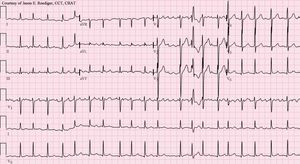Ashman phenomenon
| Ashman phenomenon | |
|---|---|
|
Atrial fibrillation with rapid ventricular response; Ashman's phenomenon with RBBB aberrancy (13th beat) | |
| Classification and external resources | |
| eMedicine | article/161028 |
Ashman phenomenon, also known as Ashman beats, describes a particular type of wide QRS complex, often seen isolated that is typically seen in atrial fibrillation. It is more often misinterpreted as a premature ventricular complex.
It is named for Dr. Richard Ashman (of New Orleans) (1890 –1969),[1] after first being described by Gouaux and Ashman in 1947.[2]
Presentation
Ashman beats are described as wide complex QRS complexes that follow a short R-R interval preceded by a long R-R interval.[3] This wide QRS complex typically has a right bundle branch block morphology and represents an aberrantly conducted complex that originates above the AV node, rather than a complex that originates in either the right or left ventricle.
Cause
It occurs because the duration of the refractory period of the myocardium is proportional to the R-R interval of the preceding cycle. A short R-R interval is associated with a shorter duration of action potential and vice versa. A long R-R cycle will prolong the ensuing refractory period, and if a shorter cycle follows, the beat terminating the cycle is likely to be conducted aberrantly. Because the refractory period of the right bundle branch is longer than the left, the right bundle will still be in the refractory period when the supraventricular impulse reaches the His-Purkinje system, resulting in a complex with right bundle branch morphology.
Prognosis
Clinically, it is often asymptomatic by itself and considered benign in nature.
References
- ↑ Kennedy LB, Leefe W, Leslie BR (2004). "The Ashman phenomenon". J La State Med Soc. 156 (3): 159–62. PMID 15233390.
- ↑ Gouaux, JL; Ashman, R (Sep 1947). "Auricular fibrillation with aberration simulating ventricular paroxysmal tachycardia.". American Heart Journal. 34 (3): 366–73. doi:10.1016/0002-8703(47)90487-0. PMID 20262631.
- ↑ "Review #1". Retrieved 2008-12-21.
Further reading
- Kennedy, LB; Leefe, W; Leslie, BR (May–Jun 2004). "The Ashman phenomenon.". The Journal of the Louisiana State Medical Society : official organ of the Louisiana State Medical Society. 156 (3): 159–62. PMID 15233390.
- Chenevert, M; Lewis, RJ (Mar–Apr 1992). "Ashman's phenomenon--a source of nonsustained wide-complex tachycardia: case report and discussion.". The Journal of Emergency Medicine. 10 (2): 179–83. doi:10.1016/0736-4679(92)90213-d. PMID 1376740.
- Tamburrini, LR; Fontanelli, A; Primossi, G (Feb 2001). "[Ventricular pre-excitation: electrophysiopathology, criteria for interpretation and clinical diagnosis. References for geriatrics].". Minerva cardioangiologica (in Italian). 49 (1): 47–73. PMID 11279385.
- Oreto, G; Luzza, F; Satullo, G; Donato, A; Carbone, V; Calabrò, MP (Sep 2009). "[Wide QRS complex tachycardia: an old and new problem].". Giornale italiano di cardiologia (2006) (in Italian). 10 (9): 580–95. PMID 19891250.
- Harrigan, RA; Garg, M (Dec 2013). "An interesting cause of wide complex tachycardia: Ashman's phenomenon in atrial fibrillation.". The Journal of Emergency Medicine. 45 (6): 835–41. doi:10.1016/j.jemermed.2013.08.018. PMID 24074525.
